While the small SUV market is getting more and more competitive every day, especially in Europe, there are also manufacturers from other countries that want their share. In this article, we chose two South Korean small crossovers and put them side by side, Hyundai Kona vs Kia Stonic.
Video comparison: Kona vs Stonic
Basic info
Hyundai Kona
Manufacturer: Hyundai Motor Company
Production: 2017 – present
Model Years: 2018 – present
Class: subcompact SUV / crossover
Assembly: Ulsan (South Korea)
Kia Stonic
Manufacturer: Kia Motors
Production (second generation): 2017 – present
Model Years: 2018 – present
Class: subcompact SUV / crossover
Assembly: Gwangmyeong (South Korea)
Exterior dimensions: Hyundai Kona vs Kia Stonic
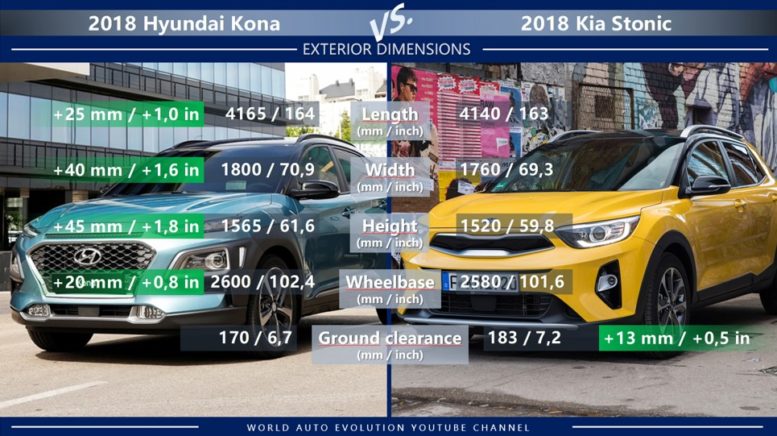
Hyundai Kona vs Kia Stonic: exterior dimension (length, width, height, wheelbase, ground clearance)
Subcompact SUVs are not meant to be large and spacious. In fact, their target audience is probably looking for a small and maneuverable city car with higher seating position. Both Kia Stonic and Hyundai Kona can provide just that. Their length of 164 and 165 inches (around 4,15 meters) guarantees to squeeze them into tightest parking spaces around shopping malls with no problems. For those who still think every inch or centimeter is important than Kona is a bit bigger than Stonic.
Interior dimensions: Hyundai Kona vs Kia Stonic
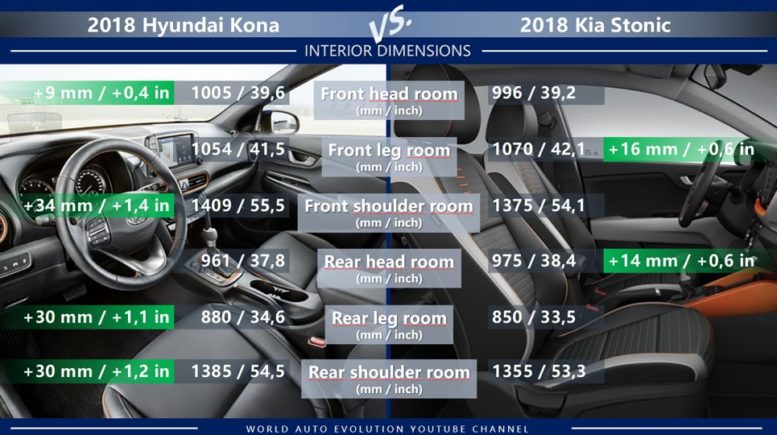
Hyundai Kona vs Kia Stonic: interior dimensions (legroom, head room, shoulder room)
Those few centimeters difference in the exterior measures is somehow mirrored into the interior dimensions. In most categories, Kona offers a bit more space (shoulder room front & rear, rear legroom), while Kia Stonic has more legroom front and headroom rear. On paper, these differences are really small and almost unnoticeable.
Kona vs Stonic luggage compartment
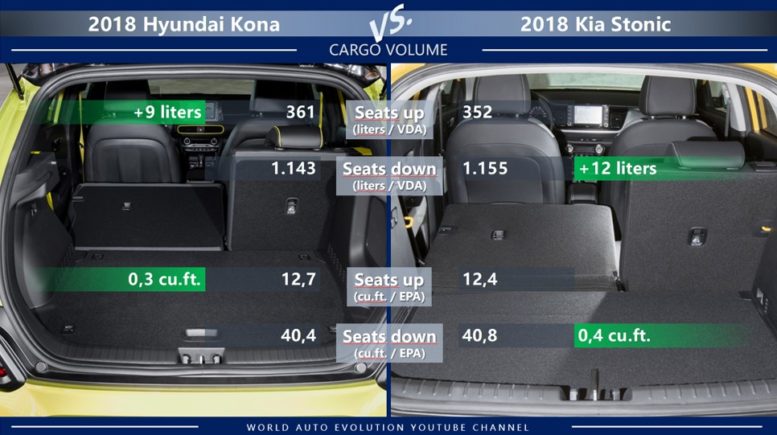
Hyundai Kona vs Kia Stonic: luggage compartment/cargo volume
If you are going to choose between Kia Stonic and Hyundai Kona based only on the size of the trunk then we tell you that there is no difference. So whether find a different criterion or write down the names of both cars on two sheets of paper and simply draw a lucky prize winner.
Hyundai Kona vs Kia Stonic engines
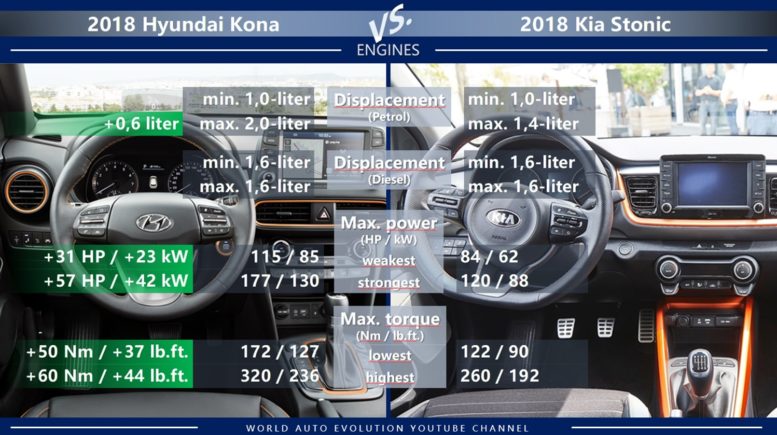
Hyundai Kona vs Kia Stonic: engines (petrol, diesel, max power, max torque)
The first noticeable difference between Hyundai Kona and Kia Stonic in the engine range. They both offer petrol and diesel versions, but the engines in Hyundai Kona have more power and more max torque compared to the ones in Kia Stonic. A big plus for Kona here, undoubtedly.
In fact, the weakest Kona almost has more power than the most powerful Stonic.
Performance: Kona vs Stonic
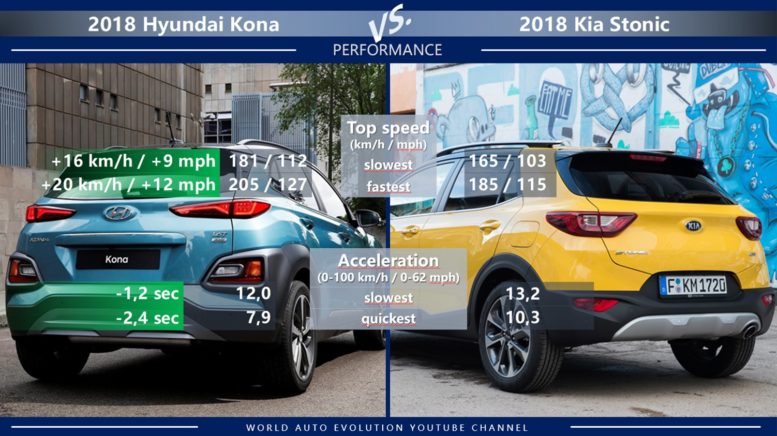
Hyundai Kona vs Kia Stonic: performance (top speed, acceleration 0-100 km/h, 0-62 mph)
Stronger engines, of course, are also reflected in better performance.
Therefore, Hyundai Kona achieves much higher top speed and reaches the speed of 100 kilometers per hour (62 miles per hour) much quicker than Stonic. Only if you choose the fastest Stonic and compete in a drag race against the slowest Kona, then you will win.
Hyundai Kona vs Kia Stonic price
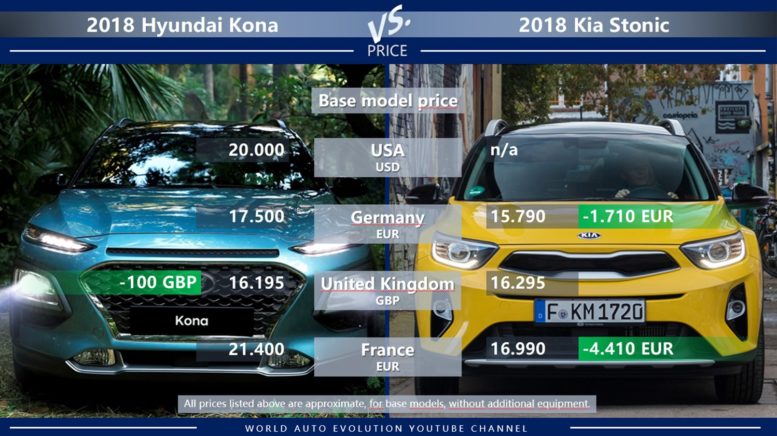
Hyundai Kona vs Kia Stonic: price comparison (USA, Germany, UK, France)
Kia has no plans to bring the Stonic to the United States, so the price comparison in the United States is not possible.
In Europe, base model Stonic is generally cheaper than base model Kona. Depending on the country, the difference can be actually over 25 percent. But there are also some countries, where the base model Kona is, in fact, cheaper than Stonic.
Final comparison: Kona or Stonic? Main differences.
Both Stonic and Kona are new and fresh models in the subcompact SUV world. Dimensionally, there are practically no differences. Maybe Kona is a little bit bigger. And we really mean a little bit. The luggage compartment is also practically the same.
We think the biggest advantage of Kona over Stonic is in its engines. More powerful engines are more attractive and can offer higher top speed and quicker acceleration. Especially if you live in the country where there is no difference in base model price.
Image credit: World Auto Evolution Youtube Channel, Kia, Hyundai
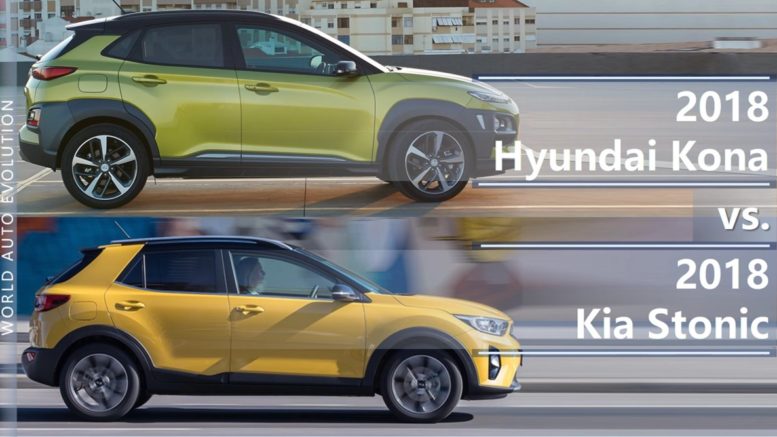

Be the first to comment on "Hyundai Kona vs Kia Stonic: Korean subcompact crossover newcomers head to head"